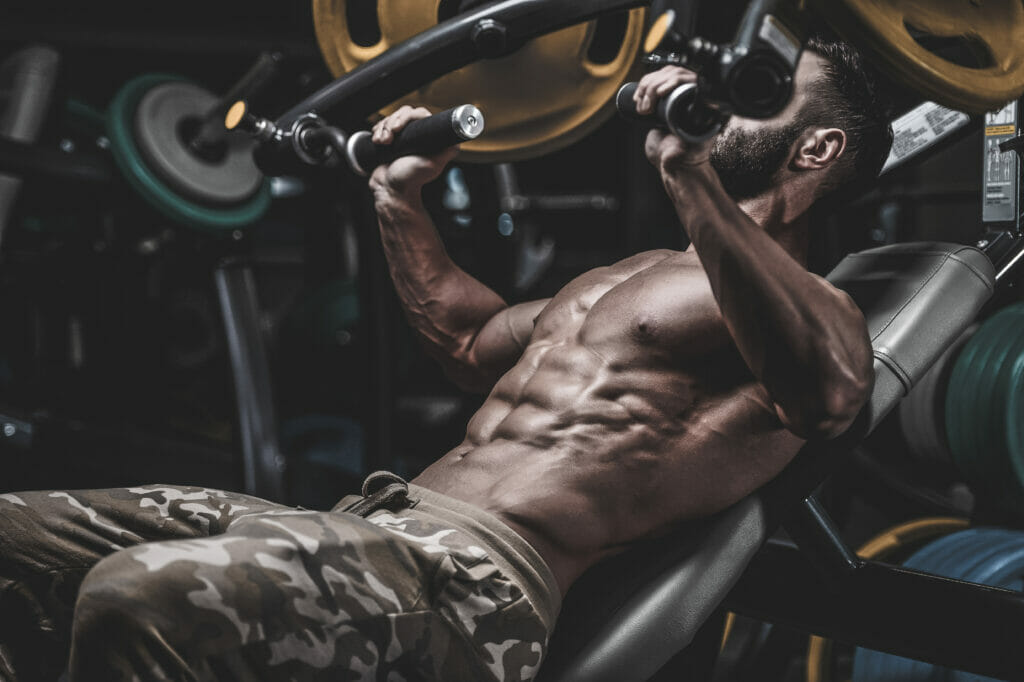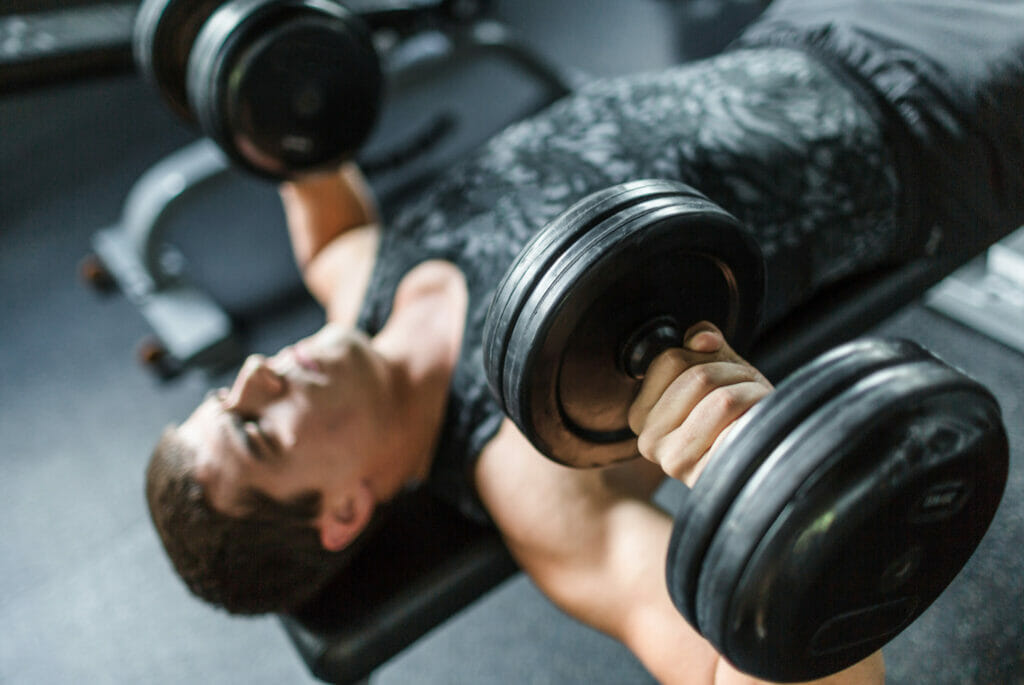
There are a lot of ways to make the most of your strength training workouts, but few are as effective as implementing supersets.
Whether you’re trying to increase the difficulty of your routine, decrease your time spent in the gym, or simply switch things up, using supersets is a great idea.
And as potent as this technique can be, it’s actually pretty straightforward – you don’t need any additional equipment and there isn’t any complex math involved.
It’s really all about decreasing your rest time.
If you’re new to using supersets in your workout, don’t worry – I’ll cover all the basics in this article.
I’ll also go over a few different ways you can use supersets to keep your workouts fresh and challenging.
What Are Supersets?
I guess we should start at the beginning.
A superset is really just the idea of doing one exercise immediately after another with no rest break in-between.
Traditional weight training promotes the idea of completing a set of exercise “A”, resting for a minute or two, and then completing set #2 of exercise “A” and so on.
And I would continue in this pattern until I finish all the sets I’m doing with exercise “A” and then I would move on to exercise “B” and the “C” and so forth.
Set #1 Exercise A → rest → Set #2 Exercise A → rest → Set #1 Exercise B → rest → Set #2 Exercise B
This older school format can work great and has provided great results for weight lifters young and old, but it has its disadvantages.
For one, you spend a lot more time resting.
Adequate rest between sets might be more important if you’re trying to lift as much weight as possible for each set, but it significantly increases how much time you’re gonna have to spend at the gym (or in your home gym).
If you’re trying to escape from the kids, hey, I get it – sometimes it’s beneficial to stretch out those workout sessions as long as possible.
But other times you just want to get your workout in and move on with your day.
Another possible disadvantage with this type of format is that your heart rate gets to return to baseline between sets.
Not only does this mean you probably aren’t burning as many calories as you could be, but it also reduces any aerobic benefits you could be getting from your lift.
Well, with supersets, you perform exercise “A” and then immediately move on to exercise “B” with as little rest as possible in-between.
After performing exercise “B”, you would then rest for a minute or two or however long your recovery period is and then repeat the 2 exercises back to back again.
Set #1 Exercise A → Set #1 Exercise B → rest → Set #2 Exercise A → Set #2 Exercise B → rest
And you would continue this pattern until you’ve completed all sets.
Using supersets can decrease recovery times and result in faster workouts. It can also keep your heart rate elevated longer, allowing you to achieve some cardio benefits too.
Not to mention the possibility of increasing your metabolism more, burning more calories, and losing more fat.
The term “superset” is generally used when talking about 2 exercises, but you could always do 3 or more exercises in this manner as well (the term “giant set” is often used when combining 4 or more exercises).
5 Ways To Implement SuperSets Into Your Workouts
Ok, now that we’re all on the same page about what this term means, let’s go over a few ways you can use supersets to rock your home workouts.

#1 Targeting Same Muscle Group
This is how I use supersets the most often because it instantly adds an extra layer of difficulty to any workout.
With this technique, you’re combining 2 exercises that target the same muscle group.
So, for example, one of my favorite chest day workouts is to perform 4 sets of standard chest press with dumbbells, resting normally between each set.
Then I do 3-4 supersets with incline chest press and incline dumbbell flys.
I’m not a professional bodybuilder or anything, but my pecs are screaming after this simple workout.
Here’s a few other same muscle group supersets I do often:
- Bent over row and lat pulldown
- Shoulder press and shoulder flys
- Supination curls and concentration curls
- Sit ups and leg raises
There are a ton of other examples we could come up with here, but the point is supersetting 2 exercises that are hitting the same muscle group is an effective way to crush whatever muscle you’re workin’.
#2 Push – Pull Split
Another popular way to use supersets is to combine opposing muscle groups, which can be a great way to work multiple areas in a short amount of time.
And the most common example of this has got to be the push-pull scenario.
With pushing exercises being moves like bench press, incline press, shoulder press, and pulling moves being stuff like bent over row, lat pulldown, cable rows, etc.
A lot of lifting schedules have chest and back landing on the same day (push-pull) and using supersets is an efficient way to get all your sets completed in a shorter amount of time.
Examples of push-pull supersets include:
- Chest press and bent over row
- Incline dumbbell press and lat pulldown
- TRX chest press and TRX row
Just beware: supersetting push and pull moves can make for a killer upper body workout, almost guaranteed to keep that heart rate elevated.
#3 More Core
I have a confession – I don’t particularly like doing core exercises.
I try to work my core 2-3x/week, but I tend to save whatever core work I plan on doing for after my lifting, and many times I’m out of gas by the time I get to my core.
So I end up either skipping core altogether (and promising myself I’ll hit it hard the next day, which I almost never do) or spending just a few minutes, doing a really short, weak core workout.
Anyway, sometimes I remedy this by supersetting core exercises with whatever strength training I’m doing that day.
And this works great because it doesn’t take anything away from my strength training and it forces me to get some core work in.
Here are a few examples of some upper/body and core supersets you can do:
- Dumbbell chest press and leg raises
- Standing dumbbell shoulder press and planks
- Bicep curls and supermen
- Bent over row and ab wheel (great for the lats too by the way)
- Goblet squats and sit ups
Something to keep in mind – if you’re supersetting planks with chest or shoulder exercises, you might find it harder to hold those planks (due to deltoid fatigue).

#4 Upper Body – Lower Body Split
You can always superset upper body and lower body exercises together too – and it’s actually a potent weapon to sneak a full body workout in.
I don’t particularly like doing leg exercises either, but something I do enjoy is supersetting shoulder exercises with leg exercises.
I often find myself pairing standing shoulder press (dumbbells) with squats or lunges and the results can be quite exhausting.
Sometimes I’ll superset chest exercises with legs too.
And if you’re looking for an efficient bodyweight workout you can do anywhere, try supersetting pushups with bodyweight squats (or lunges) and see how many sets you can knock out in 10 minutes…
Something else you can do as well – superset different full body exercises together.
For example, if you’re interested in a brutal full body workout, try supersetting burpees with kettlebell swings – trust me, it doesn’t take long to get out of breath.
There are a lot of ways to superset upper and lower body exercises and how you do it may also depend on how you break up your legs routine.
I don’t spend ton of time on my legs, so I only need a single session each week to work ’em, but you could split your leg workouts into multiple days if you’re serious.
#5 Pre-exhaustion
I have to admit, this isn’t a technique I use regularly, but I see how it could be beneficial in theory.
With pre-exhaustion, the idea is that you partially exhaust a smaller muscle group, and then perform another compound exercise that includes that same muscle group as well as another, larger muscle.
The idea being that the larger muscle will have to do more of the work because the smaller muscle will already be fatigued.
The best example of this technique would be supersetting bicep curls with bent over rows.
The biceps would be fatigued from the set of curls, so the lats and rhomboids would theoretically have to work harder during the rows.
Pre-exhaustion kinda falls under the same principle of the targeting the same muscle groups mentioned above, it’s just a specialized use of it.
Like I said, I never really use this technique, but it sounds interesting enough.
Honestly, I tend to superset in the opposite direction – I like to do the compound exercise first (rows) and superset that with the isolation exercise (curls).
Another way to pre-exhaust (which makes more sense to me), is to superset two exercises that target the same muscle in an attempt to work that muscle even harder.
This comes in handy if you have one muscle group that is weaker than another and that weak group is limiting your ability to target the stronger muscle.
Yeah, I’m not sure that made any sense, sorry.
This example will make more sense.
Say you’re trying to strengthening your pecs by doing bench press, but your triceps (not your pecs) are limiting how much weight you can bench.
You could do a pec isolation exercise (like pec flys) that don’t hit your triceps before you bench press – this way your pecs are already partially fatigued, so the triceps will be less likely to limit their workout.
Either way, supersetting exercises like this is a highly effective way to stress a group of muscles and can certainly lead to hypertrophy and strength gains.
Final Thoughts
Adding supersets to your lifting routine is a great way to increase difficulty, but it’s also a great way to speed up your workouts.
This technique can significantly cut down on rest time, which for a lot of us takes up a big portion of our total gym time.
Just know that cutting down on recovery time makes for a more challenging workout, so don’t be surprised if you can’t lift quite as much weight.
But that’s ok.
Less recovery time usually means greater gains in the long run.
Something else to keep in mind is that supersets work just as well (maybe even better) with bodyweight exercises – I mean nothing’s more classic than supersetting pushups with pull-ups.
That’s one of the most simple and most effective upper body workouts of all time.
And even if you aren’t looking to add difficulty to your workouts, adding supersets can also be a great way just to switch things up.
As a home gymer myself, I’m constantly looking for new ways to use existing equipment and I get bored easily with my routines.
And adding a superset here or there certainly freshens things up.
Well, that about does it.
If you have any questions or would like to share some of your favorite superset combos, leave a comment below and I’ll get right back to ya.


